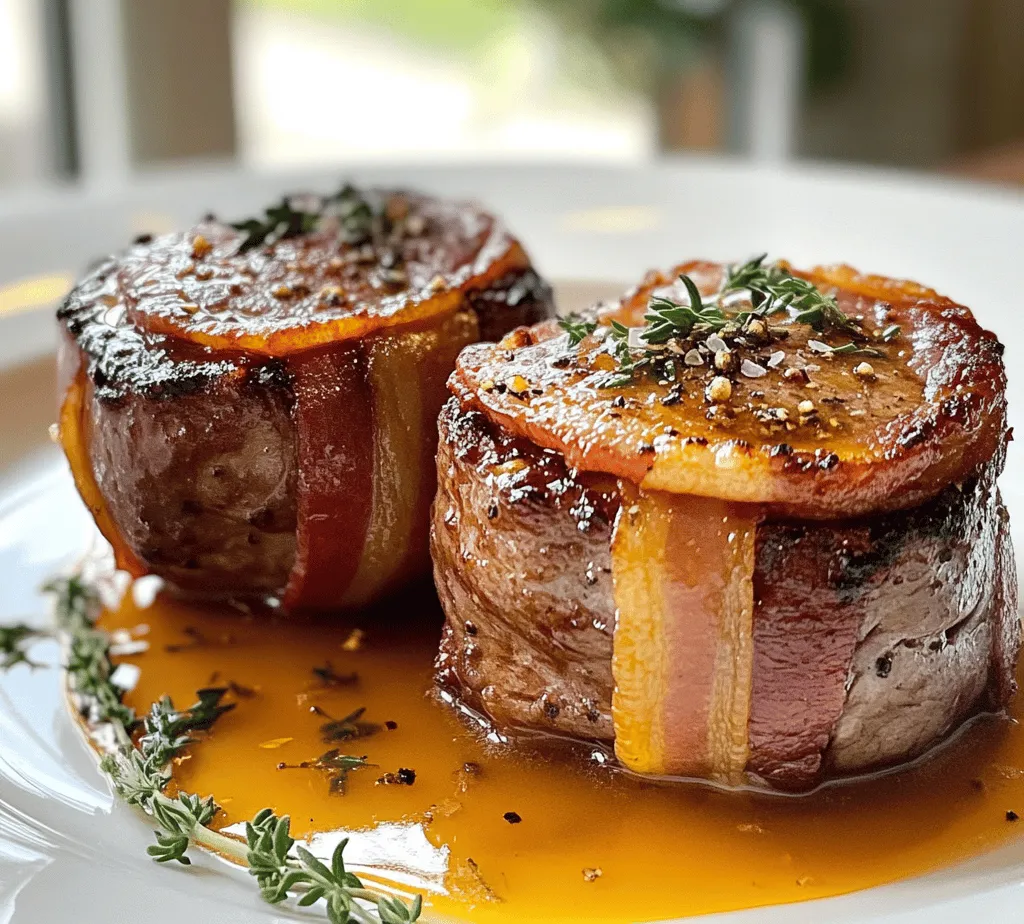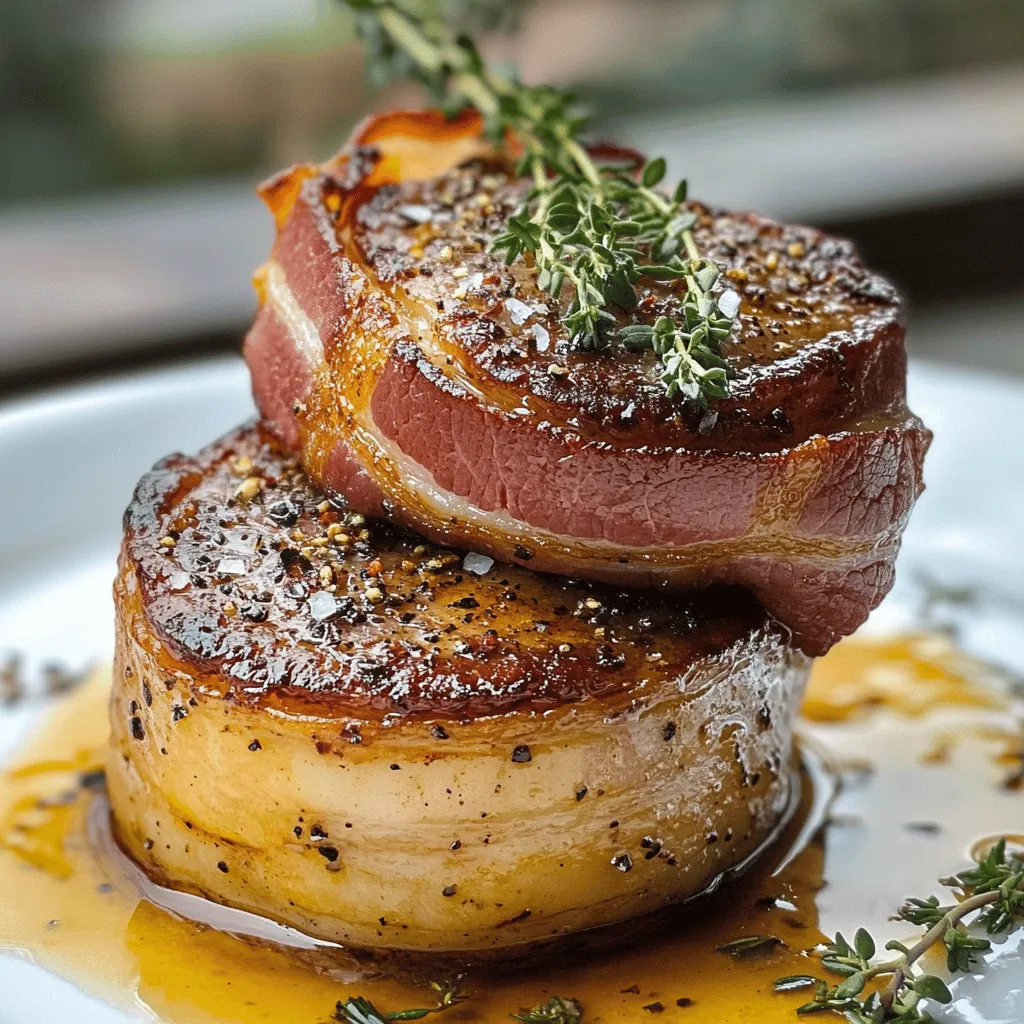Introduction
When it comes to premium cuts of meat, the filet mignon reigns supreme. Known for its tenderness and rich flavor, this cut is often considered the epitome of fine dining. Whether served at a lavish restaurant or prepared at home for a special occasion, filet mignon has a reputation for leaving a lasting impression. But what if you could elevate this already exquisite dish to new heights? Enter the Bacon Bliss Filet Mignon—a delightful fusion of flavors that marries the buttery softness of filet mignon with the savory, smoky crunch of bacon. This recipe promises to transform an ordinary dinner into an extraordinary culinary experience, making it an ideal choice for special celebrations and indulgent nights in.
Understanding Filet Mignon
Filet mignon, derived from the tenderloin of a cow, is celebrated for its exquisite texture and subtle flavor. This cut is situated along the spine, away from the animal’s muscles, which is why it remains incredibly tender. The origin of the term “filet mignon” is French, meaning “cute fillet,” and it perfectly encapsulates the delicate nature of this meat. When cooked correctly, filet mignon has a melt-in-your-mouth quality that is hard to resist.
The flavor profile of filet mignon is mild, which allows it to pair beautifully with a variety of seasonings and sauces. While some cuts of beef boast robust flavors, the filet mignon’s subtlety makes it a versatile canvas for culinary creativity. Whether you prefer it simply seasoned with salt and pepper or dressed up with rich sauces or toppings, the filet mignon is adaptable to many cooking styles.
Selecting the highest quality meat is of utmost importance when preparing filet mignon. Look for cuts that are bright red with a fine grain and minimal marbling. The marbling, or the intramuscular fat, contributes to the flavor and juiciness of the steak, so a small amount is desirable. Opting for USDA Prime or Choice grades ensures that you are purchasing a tender and flavorful cut, setting the stage for a memorable meal.
When it comes to cooking methods, filet mignon can be prepared in various ways, including grilling, pan-searing, broiling, or even sous vide. Each method offers a unique approach to enhancing the meat’s natural flavor and tenderness. For this recipe, we will focus on a combination of pan-searing and oven-roasting, which allows for a perfect crust on the outside while keeping the inside juicy and succulent.
The Role of Bacon in Gourmet Cooking
Bacon is often celebrated as one of the most beloved ingredients in the culinary world, known for its ability to elevate dishes with its rich flavor and irresistible aroma. When wrapped around filet mignon, bacon serves not only as a flavor enhancer but also as a protective layer that retains moisture during cooking. The result is a steak that is not only tender and juicy but also imbued with the smoky, savory taste of bacon.
The contrast of textures between the crispy bacon and the tender filet mignon creates a mouthwatering experience that tantalizes the palate. As the bacon cooks, it becomes beautifully caramelized, adding depth and complexity to the dish. The interplay of textures and flavors makes this combination a favorite among chefs and home cooks alike.
Culturally, bacon holds a significant place in various cuisines around the globe. From the classic American breakfast to Italian pasta dishes and beyond, bacon is a versatile ingredient that can be used in countless ways. Its ability to complement a wide range of flavors—from sweet to savory—makes it an essential component in many gourmet recipes. In the context of our Bacon Bliss Filet Mignon, it adds a layer of decadence that transforms a simple meal into a feast worthy of celebration.
Ingredients Breakdown
To create the perfect Bacon Bliss Filet Mignon, you’ll need to gather a selection of high-quality ingredients that will work in harmony to deliver an unforgettable dining experience. Here’s a detailed breakdown of each ingredient:
Filet Mignon
Selecting the right filet mignon is crucial for achieving the best results. Look for cuts that are approximately 6-8 ounces each, ensuring they are uniform in size for even cooking. Quality matters, so aim for USDA Prime or Choice grades. The filet should be bright red in color and have a fine grain with minimal visible fat. If possible, purchase your filet from a reputable butcher who can provide insights into the sourcing and handling of the meat.
Bacon
The type of bacon you choose can significantly impact the overall flavor of your dish. While standard bacon works well, consider opting for thick-cut bacon for a heartier bite and more substantial flavor. The thickness of the bacon also helps to ensure it crisps up nicely without overcooking the filet. Whether you prefer applewood smoked, hickory smoked, or even a peppered variety, each style brings its unique flavor profile to the dish.
Olive Oil
Using high-quality olive oil is essential, especially when searing the filet mignon. Olive oil not only helps to achieve a beautiful crust but also contributes to the overall flavor of the dish. Look for extra virgin olive oil, which is made from the first pressing of olives and is known for its rich taste and numerous health benefits. The monounsaturated fats in olive oil can help to enhance the flavors of the other ingredients, making it a perfect choice for this recipe.
Garlic and Rosemary
Garlic and rosemary are aromatic additions that elevate the flavor profile of the Bacon Bliss Filet Mignon. Garlic, with its distinct and robust flavor, complements the richness of both the bacon and the filet. Fresh rosemary adds an earthy, pine-like aroma that pairs beautifully with the savory notes of the dish. Both ingredients not only enhance the flavors but also provide health benefits, such as anti-inflammatory properties and antioxidants.
In the following sections, we’ll dive deeper into the step-by-step instructions for preparing this delectable dish, ensuring that every bite is as delightful as the last. Whether you’re hosting a dinner party or treating yourself to a gourmet meal at home, this Bacon Bliss Filet Mignon is sure to impress.

Butter: Its Role in Enhancing Richness and Flavor
Butter is an essential component in the preparation of the Bacon Bliss Filet Mignon. When used correctly, it elevates the dish by adding a luxurious richness and depth of flavor that complements the natural taste of the filet and the smokiness of the bacon. As you cook your steak, incorporating butter towards the end of the cooking process allows it to melt into the meat, creating a rich, velvety sauce that enhances every bite. The fat content in butter helps to carry flavors, ensuring that the herbs and spices you use become infused into the steak, creating a harmonious blend of tastes.
Optional Thyme: How It Complements the Dish
While thyme is an optional ingredient, it deserves a mention due to its aromatic qualities that pair beautifully with both beef and bacon. Fresh thyme leaves can be added to the butter during the basting process, releasing essential oils that further enhance the flavor profile of the dish. Thyme’s earthiness balances the richness of the bacon and complements the umami of the filet mignon, creating a well-rounded flavor that is sure to impress your guests.
—
Preparation Steps Explained
Preparing the Steaks: Importance of Bringing Meat to Room Temperature
Before you start cooking, it’s crucial to let your filet mignon come to room temperature. This step takes about 30-60 minutes and ensures that the steak cooks evenly. If you place cold meat directly onto a hot grill or skillet, the exterior can overcook while the interior remains undercooked. Bringing the steak to room temperature allows for a more consistent cooking process, resulting in a perfectly cooked filet mignon.
Wrapping the Bacon: Techniques for Ensuring Even Cooking and Flavor Infusion
When wrapping your filet mignon with bacon, start by laying the bacon slices flat on a cutting board. Depending on the size of your filet, you may need 1-2 slices of bacon per steak. Begin at one end of the steak, securing the bacon with toothpicks if necessary. Ensure the bacon overlaps slightly to cover the entire surface of the steak. This not only helps the bacon cook evenly but also allows the flavors to infuse into the meat as it cooks. The bacon fat will render as it cooks, basting the steak and adding incredible flavor.
Searing the Steaks: The Science Behind the Maillard Reaction and Why It’s Crucial
Searing the bacon-wrapped filet mignon is a critical step that harnesses the Maillard reaction, a chemical process that occurs when proteins and sugars in food brown at high temperatures. This reaction creates a complex flavor profile and enhances the overall taste and texture of the steak. To achieve a good sear, preheat your skillet or grill to high heat and use a small amount of oil if necessary. Place the steak in the hot pan and avoid moving it for a few minutes to allow a crust to form. Flip the steak after 3-4 minutes, ensuring a beautifully browned exterior.
Adding Flavor: The Method of Basting and Its Effect on Flavor Absorption
Basting is a technique that involves spooning melted butter (and optional thyme) over the steak while it cooks. This not only adds flavor but also helps to keep the meat moist. Once you’ve seared both sides of the filet mignon, lower the heat slightly and add a couple of tablespoons of butter to the skillet. As the butter melts, use a spoon to scoop it and drizzle it over the top of the steak. This method allows the flavors to penetrate the meat, resulting in a juicy and flavorful filet.
Baking: Understanding Oven Temperatures and Achieving the Perfect Doneness
After searing, transfer your skillet (if oven-safe) or the steaks to a preheated oven at 400°F (200°C) to finish cooking. Baking allows for even heat distribution, which is essential for achieving your desired level of doneness. For a medium-rare steak, aim for an internal temperature of 130-135°F (54-57°C), which can be monitored using a meat thermometer. This final cooking step usually takes about 5-10 minutes depending on the thickness of the steaks.
—
Perfecting the Cooking Process
Tips for Achieving the Ideal Medium-Rare Steak
To achieve the perfect medium-rare filet mignon, it’s essential to monitor the cooking time closely. Use a meat thermometer to check the internal temperature, and consider these tips:
- Remove the steak from the oven when it hits 130°F (54°C), as it will continue to cook slightly during the resting period.
- Avoid cutting into the steak immediately after cooking; this can cause juices to escape, leading to a dry bite.
Explanation of Resting Meat: How It Affects Juiciness and Flavor
Resting your filet mignon after cooking is a crucial step that should not be overlooked. Once the steak is cooked to your desired doneness, let it rest on a cutting board, loosely covered with aluminum foil, for about 5-10 minutes. This allows the juices to redistribute throughout the meat, ensuring that each slice is juicy and tender. If you slice into the steak too soon, the juices will run out, resulting in a less flavorful and dry piece of meat.
Suggested Side Dishes That Pair Well with Bacon-Wrapped Filet Mignon
To complement your Bacon Bliss Filet Mignon, consider serving a variety of side dishes that enhance the meal without overpowering it. Here are some excellent options:
- Garlic Mashed Potatoes: Creamy mashed potatoes infused with roasted garlic provide a comforting base for your steak.
- Roasted Asparagus: Lightly seasoned and roasted asparagus adds a fresh, crisp element to the plate.
- Sautéed Spinach: A simple sauté with garlic and olive oil brings a nutritious and vibrant color to the meal.
- Grilled Vegetables: A medley of seasonal vegetables grilled to perfection can enhance the flavor and texture of your dish.
—
Serving Suggestions
Presentation Ideas for an Elegant Dining Experience
When it comes to serving your Bacon Bliss Filet Mignon, presentation matters. Here are some tips to create an elegant dining experience:
- Use a Warm Plate: Warm your plates in the oven for a few minutes before serving to keep the steak hot.
- Slice at an Angle: When ready to serve, slice the steak at a 45-degree angle to showcase the juicy interior.
- Artful Plating: Arrange the sides attractively alongside the steak, using a ring mold for mashed potatoes or a fan shape for vegetables.
Ideal Accompaniments: Wine Pairings and Side Dishes That Elevate the Meal
Wine pairing can enhance the overall dining experience. For a Bacon Bliss Filet Mignon, consider these types of wines:
- Cabernet Sauvignon: A full-bodied red wine with rich tannins that perfectly complements the steak’s flavors.
- Malbec: Known for its dark fruit flavors and smooth finish, Malbec pairs beautifully with beef.
- Chardonnay: If you prefer white wine, an oaked Chardonnay can offer a creamy texture that pairs well with the richness of the dish.
Garnishing Options to Enhance Visual Appeal and Flavor
To elevate the visual appeal of your dish, consider garnishing with:
- Fresh Herbs: A sprinkle of chopped parsley or thyme can add a pop of color and a fresh flavor.
- Balsamic Reduction: Drizzling a balsamic reduction around the plate not only enhances the presentation but also adds a tangy sweetness that contrasts beautifully with the savory steak.
- Microgreens: A handful of microgreens can add a sophisticated touch and a hint of freshness.
—
Conclusion
Creating a Bacon Bliss Filet Mignon is an indulgent culinary experience that brings the gourmet restaurant vibe right into your home. The key highlights of this recipe—the rich flavors from the bacon and butter, the tender juiciness of the filet, and the aromatic touch of thyme—combine to create a dish that is both simple and elegant.
The satisfaction of serving a beautifully prepared filet mignon wrapped in bacon is unmatched, and the joy of sharing it with loved ones enhances the experience even further. Don’t hesitate to experiment with variations of this recipe, whether by trying different herbs, adding spices, or pairing with unique side dishes. Make it personal, and enjoy the process of crafting a meal that will impress and delight.


